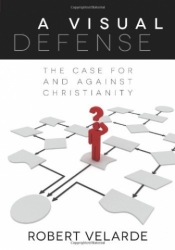Have you ever encountered an objection to the Christian faith for which you knew there was a solid rebuttal, but you could not think of it at the moment. This is one of the main challenges of apologetics — to be ready to give an answer to anyone who asks. In Robert Vellarde’s book, A Visual Defense: The Case for and against Christianity, he provides a unique and helpful way for anyone to visualize potential arguments, objections, and rebuttals with unbelievers. For those who are not quick-minded in encounters with others, this book serves as a much-needed guide to practice and see with the mind’s eye the type of real-life conversations about Christianity that happen all the time.
Vellarde explains that the purpose of the book is threefold: to help the reader learn to think critically, make the case for the Christian worldview, and seek to understand opposing views (p. 7). The book is divided into three parts. Part one introduces the reader to “argument maps,” the visualized charts that he uses throughout the volume. He uses these arguments maps on several basic questions concerning apologetics, such as, “Is Apologetics Necessary?,” “Is Intellect Essential to the Christian Life?,” and “How are Faith and Reason Related?” Each argument map begins with a conclusion, which is supported by multiple premises. These are followed by objections, rebuttals, and counter-objections. The maps appear in the form of flow charts, beginning at the top of the page and concluding at the bottom with final objections. At the end of each chapter is a series of discussion questions and suggested assignments.
In the pages that follow, further explanation is given of the short descriptions in each text box of the flow chart. The value of this book is that it helps the reader visualize how conversations unfold, how an unbeliever might respond to a Christian’s arguments, and how to rebut the objections. The topics covered in Part 2 are various arguments for God and Christianity, including the existence of God, the objective nature of truth and morality, the benefit of Christianity, the resurrection and uniqueness of Christ, the argument from desire, Pascal’s wager, the explanation of evil, and the justice of hell. In these chapters, the arguments are typically of an evidentialist nature, arguing mostly for probability, rather than logical necessity. Because the book is concerned with visual maps, there is no discussion on approaches in apologetics. It is decidedly evidentialist, and the list of resources in the annotated bibliography reflects this.
Part 3 presents arguments against God and Christianity. The value here is to trace arguments from the side of unbelievers, through objections and rebuttals. These chapters deal with some of the most common unbelieving arguments, such as that God does not exist, belief in God is delusional, Christianity is harmful, all religions are essentially true, and evil is an illusion.
A Visual Defense is a valuable book, not least because of its format as a visual aid in apologetics. It is a useful tool to help believer begin to develop the ability to engage in a sustained apologetic conversation with unbelievers, and to strengthen their own faith. A welcome supplement would be a similar volume visualizing arguments from a transcendental, or presuppositional approach. This work, however, is a welcome contribution to the study of apologetics, and many will find it indispensible.
Mark Farnham (PhD, Westminster Theological Seminary) is Associate Professor and Coordinator of Pastoral and Preseminary Majors at Lancaster Bible College.
Buy the books

A Visual Defense: The Case For and Against Christianity